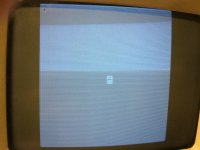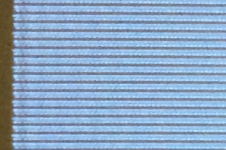After a long break I finally got another chance to look at this. Since it's clear that some sort of phase-locking will be needed, and simple ratios of the video frequency won't always line up with the original 22.25kHz horizontal scan rate, I decided to test the effect of scan frequency on the voltages produced by the sweep circuit.
I did the tests on my modified analog board which has a 100uH inductor in place of the horizontal deflection coil. I measured three points on the board where the BOMARC schematic gives typical readings:
- C18 which comes from pin 8 of the flyback. This voltage powers the video amplifier on the CRT board. BOMARC says it should read +32V.
- C19 whose signal derives from pin 7 of the flyback. This voltage ultimately goes to the brightness potentiometer. BOMARC says it should read -106V.
- C27 whose signal also derives from pin 7 of the flyback. This voltage powers the focus and cut-off potentiometers. BOMARC says it should read +811V. Since I don't have a HV probe, I'm taking this to be the closest proxy for the CRT anode voltage.
On my modified setup, at standard 22.25kHz scan rate, I read 25.2V, -103V and 691V, respectively. So two of the three are somewhat reduced. (That said, when driven with the original resolution video, the picture is a normal size and in good focus, so it can't be that far off the original values.)
Increasing the scan rate reduces the high voltage on C27, which is what one might expect: a faster scan rate means less time to accumulate energy in the yoke and flyback. Through 23.0kHz I didn't observe much change, but by 24.0kHz it fell to 670V, at 24.5kHz it fell to 655V, 25.0kHz it was 638V and by 26.0kHz it was down to 597V. There was a roughly corresponding drop in the brightness voltage. Weirdly, the voltage on C18 went *up* as the scan rate increased: from 25.2V at 22.25kHz up to 25.9V at 26.0kHz. As the frequency goes up, the picture gets bigger, indicating that the CRT anode voltage is dropping.
As might be expected, dropping the scan rate had the opposite effect. At 21.0kHz, the high voltage went from 691V up to 746V; at 20.0kHz it was up to 780V; at 19.0kHz it was 794V, and at 18.0kHz it was up to 833V (about 20% higher). Again, the effect on C19 was similar, but C18 went the opposite way, dropping from 25.2V down to 24.1V.
TL;DR: I think this circuit could be operated in roughly the range 19kHz to 25kHz and still have plausible voltages to work with. Above that the performance is poor; below that might damage the board.
I haven't yet built a phase-locking circuit, but I tried to preview the result by driving the flyback with a signal generator tuned to exactly 2/3 of the video frequency. Here I used a Mac 13" 640x480 resolution (35.03kHz to yoke, 23.35kHz to flyback). This is the result:

What this shows is a pattern of stripes every three lines. The pattern is stable if I match the frequency ratio exactly, otherwise it slowly processes up or down the screen. Here is a zoom of the edge:

You can see there is a slight horizontal offset alongside a significant change in brightness. It turns out that if you follow the individual scan lines across the screen, you can see that it slowly gets dimmer over about 2 lines and then gets brighter over slightly less than 1 line.
Basically, as previously discussed on this thread, I think we're seeing the CRT charging and discharging. The question is what to do about it! Phase locking will keep the pattern still, but it won't get rid of it. As long as the frequencies are mismatched, there will be some lines brighter than others. It's possible this means the whole two-frequency solution is unworkable, but I wonder if there's some other way to compensate for the brightness change and/or keep the voltage more stable without hooking up a giant HV capacitor to the CRT anode.


